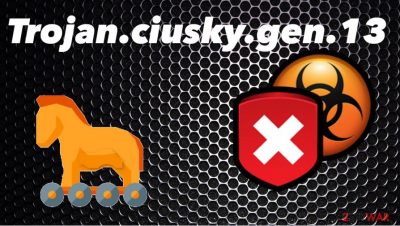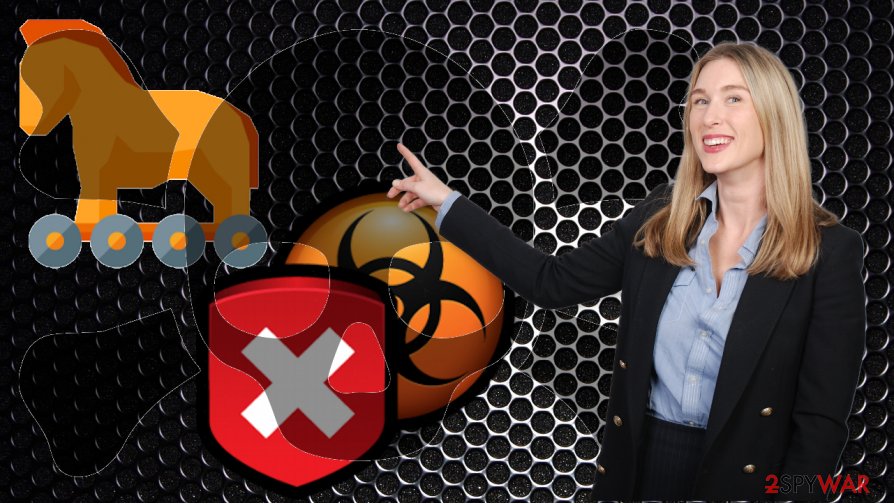Trojan.ciusky.gen.13 (Free Guide) - Removal Instructions
Trojan.ciusky.gen.13 Removal Guide
What is Trojan.ciusky.gen.13?
Trojan.ciusky.gen.13 the malware detection alert that appears on the screen when the AV tool detects danger

It is a Windows operating system issue, so when you get the pop-up or find a file on the macOS machine,[2] your device cannot get affected. However, a file like this can show up when you open the malicious attachment. If so, the real Trojan.ciusky.gen.13 virus might spread on a different device of yours and infect the system there, damage functions, files. You need to determine the particular reason you see these alerts, in the first place, before doing anything else.
| Name | Trojan.ciusky.gen.13 |
|---|---|
| Type | Trojan malware or false positive detection caused by incompatibility issues |
| Issues | The virus can create processes and launch programs that trigger damage in the system. Trojan can automatically install other threats and infect the machine further. In most cases, trojans run in the system unnoticed and can vanish the same way – silently |
| Distribution | The threat comes during the installation of a malicious program or from the email that includes dangerous file as the attachment. Many threats can install trojans directly on the computer too |
| Diagnostics | The best way to tell if the suspicious detection alert is true or not related to any malware- use the alternate anti-malware tools. Run a scan using SpyHunter 5Combo Cleaner or Malwarebytes and check if the antivirus engine finds any intruders. If not, it most likely a false positive |
| Elimination | Of you need to remove Trojan.ciusky.gen.13 as a threat that causes issues, you should rely on the particular AV tool that indicated danger for you. It is the best way to fight any malware |
| Repair | Trojans and other more intrusive and dangerous, but silent threats can damage the system significantly and affect functions. Rely on optimization software or PC repair tools like FortectIntego that can help fix the damage and corrupted files or programs |
If your device is affected by Trojan.ciusky.gen.13 virus, you might encounter crashes and slowdowns that are not related to any other actions or functions of the machine. It enters the computer without any permission and can interfere with various system functions, start malicious activities, or destroy serious files.
Trojan.ciusky.gen.13 is a silent yet very dangerous threat that can be used by hackers to perform various operations from mining cryptocurrency[3] to spreading ransomware around. The threat can hide deep in the system and users do not see any symptoms, so the detection is the only indication that can tell about the infection.
Unfortunately, without anti-malware tools, you cannot remove Trojan.ciusky.gen.13 yourself. There are no programs or files that could be deleted to terminate the virus properly, so the AV engine can show what intruder the system has and eliminate them sully with all the associated files or applications.
Make sure to choose a particular anti-malware tool that is reliable and can help with this Trojan.ciusky.gen.13 removal procedure. We can offer to choose SpyHunter 5Combo Cleaner or Malwarebytes as your go-to security tools, but remember that mano AV engines use different virus databases and cannot shot the same results or perform the same. This is why you can select from a variety of programs out there.
Trojan.ciusky.gen.13 false positive can occur when you have two separate AV tools on the machine. If you run real-time protection by both software, you can trigger such alerts. Run one tool and turn off the other, so you can check the system separately. VirusTotal is the platform for uploading malicious files. You can check the purpose of a suspicious file or program there.

Malicious files that trigger malware installations can be hidden
Spam emails, promotional campaigns, and other methods that involve deceptive content help to spread malware like trojans, worms, and ransomware, around. You might not even notice when the malicious file gets dropped on the machine because you fall for the misleading material and open emails with attached files without paying close attention to them.
You should pay attention to senders, email notifications that state about suspicious information, orders, receipts, and promotions. Such email campaigns are designed to trick people into downloading suspicious files as MS documents, PDFs. The best tip would be to delete any suspicious emails once received and avoid clicking on anything that you are not sure about.
Check for real threats and get rid of the Trojan.ciusky.gen.13 malware
You may need to remove Trojan.ciusky.gen.13 if it is the virus that managed to get on your device. However, some compatibility issues and corrupted files can trigger these pop-ups. Try to repair the system with FortectIntego if your diagnostic tools showed no danger and make sure that the computer is working properly.
As it was mentioned, Trojan.ciusky.gen.13 virus is related to particular AV and compatibility issues triggered by games, files, programs, other components. You should re-download files that got removed by the AV tool or trigger the detection alert. Or install the game from scratch or a program, if needed.
If you need help in choosing the anti-malware tool or the process is impossible because the threat blocks your programs try the Safe Mode. You can reboot the PC and then run SpyHunter 5Combo Cleaner or Malwarebytes to perform Trojan.ciusky.gen.13 removal safely. Such a virus termination method can be followed in the guide below.
Getting rid of Trojan.ciusky.gen.13. Follow these steps
Manual removal using Safe Mode
Important! →
Manual removal guide might be too complicated for regular computer users. It requires advanced IT knowledge to be performed correctly (if vital system files are removed or damaged, it might result in full Windows compromise), and it also might take hours to complete. Therefore, we highly advise using the automatic method provided above instead.
Step 1. Access Safe Mode with Networking
Manual malware removal should be best performed in the Safe Mode environment.
Windows 7 / Vista / XP
- Click Start > Shutdown > Restart > OK.
- When your computer becomes active, start pressing F8 button (if that does not work, try F2, F12, Del, etc. – it all depends on your motherboard model) multiple times until you see the Advanced Boot Options window.
- Select Safe Mode with Networking from the list.

Windows 10 / Windows 8
- Right-click on Start button and select Settings.

- Scroll down to pick Update & Security.

- On the left side of the window, pick Recovery.
- Now scroll down to find Advanced Startup section.
- Click Restart now.

- Select Troubleshoot.

- Go to Advanced options.

- Select Startup Settings.

- Press Restart.
- Now press 5 or click 5) Enable Safe Mode with Networking.

Step 2. Shut down suspicious processes
Windows Task Manager is a useful tool that shows all the processes running in the background. If malware is running a process, you need to shut it down:
- Press Ctrl + Shift + Esc on your keyboard to open Windows Task Manager.
- Click on More details.

- Scroll down to Background processes section, and look for anything suspicious.
- Right-click and select Open file location.

- Go back to the process, right-click and pick End Task.

- Delete the contents of the malicious folder.
Step 3. Check program Startup
- Press Ctrl + Shift + Esc on your keyboard to open Windows Task Manager.
- Go to Startup tab.
- Right-click on the suspicious program and pick Disable.

Step 4. Delete virus files
Malware-related files can be found in various places within your computer. Here are instructions that could help you find them:
- Type in Disk Cleanup in Windows search and press Enter.

- Select the drive you want to clean (C: is your main drive by default and is likely to be the one that has malicious files in).
- Scroll through the Files to delete list and select the following:
Temporary Internet Files
Downloads
Recycle Bin
Temporary files - Pick Clean up system files.

- You can also look for other malicious files hidden in the following folders (type these entries in Windows Search and press Enter):
%AppData%
%LocalAppData%
%ProgramData%
%WinDir%
After you are finished, reboot the PC in normal mode.
Remove Trojan.ciusky.gen.13 using System Restore
-
Step 1: Reboot your computer to Safe Mode with Command Prompt
Windows 7 / Vista / XP- Click Start → Shutdown → Restart → OK.
- When your computer becomes active, start pressing F8 multiple times until you see the Advanced Boot Options window.
-
Select Command Prompt from the list

Windows 10 / Windows 8- Press the Power button at the Windows login screen. Now press and hold Shift, which is on your keyboard, and click Restart..
- Now select Troubleshoot → Advanced options → Startup Settings and finally press Restart.
-
Once your computer becomes active, select Enable Safe Mode with Command Prompt in Startup Settings window.

-
Step 2: Restore your system files and settings
-
Once the Command Prompt window shows up, enter cd restore and click Enter.

-
Now type rstrui.exe and press Enter again..

-
When a new window shows up, click Next and select your restore point that is prior the infiltration of Trojan.ciusky.gen.13. After doing that, click Next.


-
Now click Yes to start system restore.

-
Once the Command Prompt window shows up, enter cd restore and click Enter.
Finally, you should always think about the protection of crypto-ransomwares. In order to protect your computer from Trojan.ciusky.gen.13 and other ransomwares, use a reputable anti-spyware, such as FortectIntego, SpyHunter 5Combo Cleaner or Malwarebytes
How to prevent from getting malware
Stream videos without limitations, no matter where you are
There are multiple parties that could find out almost anything about you by checking your online activity. While this is highly unlikely, advertisers and tech companies are constantly tracking you online. The first step to privacy should be a secure browser that focuses on tracker reduction to a minimum.
Even if you employ a secure browser, you will not be able to access websites that are restricted due to local government laws or other reasons. In other words, you may not be able to stream Disney+ or US-based Netflix in some countries. To bypass these restrictions, you can employ a powerful Private Internet Access VPN, which provides dedicated servers for torrenting and streaming, not slowing you down in the process.
Data backups are important – recover your lost files
Ransomware is one of the biggest threats to personal data. Once it is executed on a machine, it launches a sophisticated encryption algorithm that locks all your files, although it does not destroy them. The most common misconception is that anti-malware software can return files to their previous states. This is not true, however, and data remains locked after the malicious payload is deleted.
While regular data backups are the only secure method to recover your files after a ransomware attack, tools such as Data Recovery Pro can also be effective and restore at least some of your lost data.
- ^ Trojan.Ciusky.Gen.13 virus???. Steamcommunity. Forum.
- ^ How can I remove a Trojan.Ciusky.Gen.13 virus?. Discussions. Apple community forum.
- ^ cryptocurrency mining. Webopedia. IT and security terms.





















